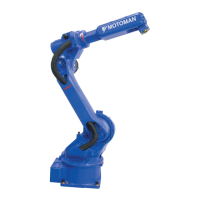5-13
168542-1CD
168542-1CD
MLX200 Software and
Operations
5 Collision Detection
5.3 Using the MLxRobotCollisionDetection Instruction
This can be expanded for more complicated application scenarios as well.
For example, consider the simple picking sequence shown in Fig. 5-13.
The robot moves from P1 to an approach point at P2 and then to a pick
location at P3. Then, the robot moves back through the approach point at
P2 to a waypoint at P1. In this kind of application it may be desirable to
activate many different Collision Files throughout the application: one for
general point-to-point motions without product, one specifically for picking/
placing parts, one for general point-to-point motions with product, etc.
Fig. 5-13: Simple Picking Sequence
To achieve this, the Collision File can be changed throughout the
application cycle as shown as a flowchart in Fig. 5-14. In this example, an
initial Collision File (#1) is activated at the beginning of the sequence.
Then, the Collision File is changed to #2 before the motion down to grasp
the object. Then, a new Collision File (#3) is activated after the object has
been picked to more accurately match the loading of the system. This
application logic could be further expanded to do a similar sequence on
the place side as well.
Fig. 5-14: Flow Chart of Changing Collision Files during Application

